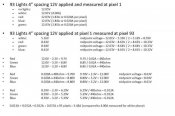nutz4lights
Full time elf
- Thread starter
- #16
I had some more time so I pulled out my 93 pixel string (don't ask) of 12V square-type pixels with 10cm spacing and made the same measurements outlined above. Please see the picture below... Some commentary... it appears that these are 0.020A per color LED elements. I know Eddy's 12V versus 5V sticky says that most or some of the 12V pixel lights use 10mA, so I was surprised to see a current draw of 0.020A on these. The bottom two sets of numbers are a bit off, but the measurements are the measurements... and I believe the calculations are correct.
[attachimg=1]
I'm just going to throw this out there... but based on what I'm seeing from these measurements, I am very tempted to go with 12V lighting. I have read the 12V versus 5V thread and I can see the following reasons for not using 12V lighting:
1. 12V will use and waste a lot more power than 5V requiring more power supplies
2. 12V will dissipate a lot more heat than 5V due to the wasted energy
3. 12V will output less light than 5V due to running at lower current
#3 is just plain not true for the setup I'm looking at. The colors are running between 13mA and 15mA in color mode for the 5V and spot-on at 20mA in color mode for the 12V. If anything, for my setup, the 12V lights should output more light than the 5V lights in my possession. #2 there's no getting away from, that is definitely going to happen. I let the 12V string run for a good hour tonight and I didn't feel the injection molded section getting warm, which is good, but there's no arguing that #2 will happen. #1 is a bit trickier... There's really no arguing that 5V will require a lower wattage power supply and the math below agrees with that... but I also don't like the thought of under-driving the pixels producing lower current ratings...
- Twelve outputs, 100 pixels per output, 12V draws 4.0A per output running white which means 48A / 80% = 60A x 12V = 720W worth of power (I think I'd be ok with two 350W power supplies) Twelve outputs, 100 pixels per output, 5V draws 1.2A per output running white which means 14.4A / 80% = 18A x 5V = 90W worth of power.
I dunno... the thought of just running one cable to a pixel string per output of the P12R is appealing (no power injection). The cost difference between a single 5V power supply ($15) and two 350W power supplies ($40) is not really all that bad...
If the lights put out less light, that would be a huge negative... more power supplies just can't be the show-stopper here considering how cheap they are, right?
Thanks for reading,
[attachimg=1]
I'm just going to throw this out there... but based on what I'm seeing from these measurements, I am very tempted to go with 12V lighting. I have read the 12V versus 5V thread and I can see the following reasons for not using 12V lighting:
1. 12V will use and waste a lot more power than 5V requiring more power supplies
2. 12V will dissipate a lot more heat than 5V due to the wasted energy
3. 12V will output less light than 5V due to running at lower current
#3 is just plain not true for the setup I'm looking at. The colors are running between 13mA and 15mA in color mode for the 5V and spot-on at 20mA in color mode for the 12V. If anything, for my setup, the 12V lights should output more light than the 5V lights in my possession. #2 there's no getting away from, that is definitely going to happen. I let the 12V string run for a good hour tonight and I didn't feel the injection molded section getting warm, which is good, but there's no arguing that #2 will happen. #1 is a bit trickier... There's really no arguing that 5V will require a lower wattage power supply and the math below agrees with that... but I also don't like the thought of under-driving the pixels producing lower current ratings...
- Twelve outputs, 100 pixels per output, 12V draws 4.0A per output running white which means 48A / 80% = 60A x 12V = 720W worth of power (I think I'd be ok with two 350W power supplies) Twelve outputs, 100 pixels per output, 5V draws 1.2A per output running white which means 14.4A / 80% = 18A x 5V = 90W worth of power.
I dunno... the thought of just running one cable to a pixel string per output of the P12R is appealing (no power injection). The cost difference between a single 5V power supply ($15) and two 350W power supplies ($40) is not really all that bad...
If the lights put out less light, that would be a huge negative... more power supplies just can't be the show-stopper here considering how cheap they are, right?
Thanks for reading,


